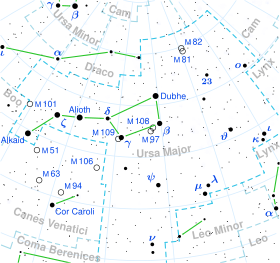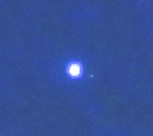
| |
| Observation data Epoch J2000 Equinox J2000 | |
|---|---|
| Constellation | Ursa Major |
| Pronunciation | /ˈdʌbiː/ |
| Right ascension | 11 03 43.67152 |
| Declination | +61° 45′ 03.7249″ |
| Apparent magnitude (V) | 1.79 (1.87 + 4.85) |
| Characteristics | |
| Spectral type | K0III + A5V |
| U−B color index | +0.93 |
| B−V color index | +1.07 |
| Variable type | Suspected |
| Astrometry | |
| Radial velocity (Rv) | −9.4±0.3 km/s |
| Proper motion (μ) | RA: –134.11 mas/yr Dec.: –34.70 mas/yr |
| Parallax (π) | 26.54 ± 0.48 mas |
| Distance | 123 ± 2 ly (37.7 ± 0.7 pc) |
| Absolute magnitude (MV) | −1.10±0.04 |
| Orbit | |
| Companion | α UMa B |
| Period (P) | 44.45±0.11 yr |
| Semi-major axis (a) | 0.590±0.026″ |
| Eccentricity (e) | 0.439±0.004 |
| Inclination (i) | 159.9±3.5° |
| Longitude of the node (Ω) | 9.3±8.2° |
| Periastron epoch (T) | 2,002.17±0.09 |
| Argument of periastron (ω) (secondary) | 232.8±7.9° |
| Details | |
| α UMa A | |
| Mass | 3.7±0.4 M☉ |
| Radius | 26.85 R☉ |
| Luminosity | 339 L☉ |
| Surface gravity (log g) | 2.22 cgs |
| Temperature | 4,650 K |
| Metallicity | –0.15 dex |
| Rotation | <1.35 years |
| Rotational velocity (v sin i) | 2.63±0.15 km/s |
| Age | 280±30 Myr |
| α UMa B | |
| Mass | 2.5±0.4 M☉ |
| Other designations | |
| Dubhe, Ak, α Ursae Majoris, α UMa, Alpha UMa, 50 UMa, NSV 5070, BD+62°1161, FK5 417, GC 15185, HD 95689, HIP 54061, HR 4301, SAO 15384, PPM 17705, ADS 8035, CCDM J11037+6145AB, WDS J11037+6145AB | |
| Database references | |
| SIMBAD | data |
Dubhe is a multiple star system in the northern constellation of Ursa Major. It is formally designated Alpha Ursae Majoris, Latinised from α Ursae Majoris, Despite being designated "α" (alpha), it is the second-brightest object in the constellation. Alpha Ursae Majoris is the northern of the 'pointers' (or 'guards'), the second being Beta Ursae Majoris, or 'Merak' – this pair of stars point towards Polaris, the North Star. α Ursae Majoris is located at a distance of approximately 123 light years from the Sun, based on parallax measurements.
Although it is part of the constellation of Ursa Major, it is not part of the Ursa Major Moving Group of stars that have a common motion through space.
Components

This is a spectroscopic binary made up of the stars designated α Ursae Majoris A and α Ursae Majoris B. The pair orbit at a separation of about 23 astronomical units (AU) with a period of 44.5 years and an eccentricity (ovalness) of 0.44. There is another spectroscopic binary at an angular separation of 7.1 arcminutes, forming a 7th magnitude pair showing an F8 spectral type with an orbital period of 6.035 days and an eccentricity of 0.09. It is sometimes referred to as Alpha Ursae Majoris C, but is separately catalogued as HD 95638. Together they form a quadruple star system.

Component A is the system's primary, and it has a stellar classification of K0III. This is a giant star that has evolved away from the main sequence after consuming the hydrogen at its core. It is 280 million years old with 3.7 times the Sun's mass and has expanded 26 times the radius of the Sun. The star is radiating 340 times the luminosity of the Sun from its enlarged photosphere at an effective temperature of 4,650 K. The secondary star, component B, is an A-type main-sequence star that has a class of A5V. α Ursae Majoris has been reported to vary in brightness by about a thousandth of a magnitude. Ten radial oscillation modes have been detected, with periods between 6.4 hours and 6.4 days.
Nomenclature
α Ursae Majoris (Latinised to Alpha Ursae Majoris) is the star system's Bayer designation.
It bore the traditional name Dubhe, which is derived from the Arabic for 'bear', dubb, from the phrase ظهر الدب الاكبر żahr ad-dubb al-akbar 'the back of the Greater Bear'. The ancient Egyptians called it Ak, meaning 'The Eye'. In 2016, the International Astronomical Union organized a Working Group on Star Names (WGSN) to catalog and standardize proper names for stars. The WGSN's first bulletin of July 2016 included a table of the first two batches of names approved by the WGSN; which included Dubhe for the star α Ursae Majoris A.
The Hindus refer to the star as Kratu, one of the Seven Rishis.
In Chinese, 北斗 Běi Dǒu, meaning Northern Dipper, refers to an asterism equivalent to the Big Dipper. Consequently, the Chinese name for Alpha Ursae Majoris itself is 北斗一 Běi Dǒu yī, (English: the First Star of Northern Dipper) and 天樞 Tiān Shū, (English: Star of Celestial Pivot).
In culture
Dubhe is the official star of the State of Utah.
Dubhe was a ship in the United States Navy. The Danish National Home Guard Navy ship MHV806 is also named Dubhe.
See also
References
- ^ van Leeuwen, F. (November 2007). "Validation of the new Hipparcos reduction". Astronomy and Astrophysics. 474 (2): 653–664. arXiv:0708.1752. Bibcode:2007A&A...474..653V. doi:10.1051/0004-6361:20078357. S2CID 18759600.
- ^ Johnson, H. L.; et al. (1966), "UBVRIJKL photometry of the bright stars", Communications of the Lunar and Planetary Laboratory, 4 (99): 99, Bibcode:1966CoLPL...4...99J
- ^ Gray, David F. (December 2018). "Spectroscopy of the K0 Binary Giant α UMa". The Astrophysical Journal. 869 (1): 14. Bibcode:2018ApJ...869...81G. doi:10.3847/1538-4357/aae9e6. S2CID 125789271. 81.
- ^ Guenther, D. B.; et al. (2000). "Evolutionary Model and Oscillation Frequencies for α Ursae Majoris: A Comparison with Observations". The Astrophysical Journal. 530 (1): L45 – L48. Bibcode:2000ApJ...530L..45G. doi:10.1086/312473. PMID 10642202.
- Samus, N. N.; Durlevich, O. V.; et al. (2009). "VizieR Online Data Catalog: General Catalogue of Variable Stars (Samus+ 2007-2013)". VizieR On-line Data Catalog: B/GCVS. Originally Published in: 2009yCat....102025S. 1. Bibcode:2009yCat....102025S.
- Gontcharov, G. A. (November 2006). "Pulkovo Compilation of Radial Velocities for 35 495 Hipparcos stars in a common system". Astronomy Letters. 32 (11): 759–771. arXiv:1606.08053. Bibcode:2006AstL...32..759G. doi:10.1134/S1063773706110065. S2CID 119231169.
- Carney, Bruce W.; et al. (March 2008), "Rotation and Macroturbulence in Metal-Poor Field Red Giant and Red Horizontal Branch Stars", The Astronomical Journal, 135 (3): 892–906, arXiv:0711.4984, Bibcode:2008AJ....135..892C, doi:10.1088/0004-6256/135/3/892, S2CID 2756572
- Gray, David F.; Kaur, Taranpreet (2019-09-01). "A Recipe for Finding Stellar Radii, Temperatures, Surface Gravities, Metallicities, and Masses Using Spectral Lines". The Astrophysical Journal. 882 (2): 148. Bibcode:2019ApJ...882..148G. doi:10.3847/1538-4357/ab2fce. ISSN 0004-637X.
- ^ Luck, R. Earle (2015-09-01). "Abundances in the Local Region. I. G and K Giants". The Astronomical Journal. 150 (3): 88. arXiv:1507.01466. Bibcode:2015AJ....150...88L. doi:10.1088/0004-6256/150/3/88. ISSN 0004-6256. Dubhe's database entry at VizieR.
- ^ Baines, E.; et al. (2017). "Fundamental Parameters of 87 Stars from the Navy Precision Optical Interferometer". The Astronomical Journal. 155 (1): 30. arXiv:1712.08109. Bibcode:2018AJ....155...30B. doi:10.3847/1538-3881/aa9d8b. S2CID 119427037.
- "DUBHE -- Spectroscopic binary", SIMBAD, Centre de Données astronomiques de Strasbourg, retrieved 2011-12-23
- Kunitzsch, Paul; Smart, Tim (2006). A Dictionary of Modern star Names: A Short Guide to 254 Star Names and Their Derivations (2nd rev. ed.). Cambridge, Massachusetts: Sky Pub. ISBN 978-1-931559-44-7.
- "IAU Catalog of Star Names". Retrieved 28 July 2016.
- Streicher, Magda (April 2009). "Plough northwards, to the Big Dipper". Monthly Notes of the Astronomical Society of South Africa. 68 (3 and 4): 78–83. Bibcode:2009MNSSA..68...78S.
- Motz, Lloyd; Nathanson, Carol (1988). The Constellations: An Enthusiast's Guide To The Night Sky. Doubleday. p. 39. ISBN 978-0385176002.
- ^ Tokovinin, A. A. (1997). "MSC - a catalogue of physical multiple stars". Astronomy and Astrophysics Supplement Series. 124: 75–84. Bibcode:1997A&AS..124...75T. doi:10.1051/aas:1997181.
- Eggleton, P. P.; Tokovinin, A. A. (September 2008). "A catalogue of multiplicity among bright stellar systems". Monthly Notices of the Royal Astronomical Society. 389 (2): 869–879. arXiv:0806.2878. Bibcode:2008MNRAS.389..869E. doi:10.1111/j.1365-2966.2008.13596.x. S2CID 14878976.
- Buzasi, D.; Catanzarite, J.; Laher, R.; Conrow, T.; Shupe, D.; Gautier, T. N.; Kreidl, T.; Everett, D. (2000). "The Detection of Multimodal Oscillations on α Ursae Majoris". The Astrophysical Journal. 532 (2): L133 – L136. arXiv:astro-ph/0002512. Bibcode:2000ApJ...532L.133B. doi:10.1086/312573. PMID 10715242. S2CID 119057234.
- ^ Allen, R. H. (1963). Star Names: Their Lore and Meaning (Reprint ed.). New York: Dover Publications Inc. p. 438. ISBN 0-486-21079-0. Retrieved 2012-09-04.
- "IAU Working Group on Star Names (WGSN)". Retrieved 22 May 2016.
- "Bulletin of the IAU Working Group on Star Names, No. 1" (PDF). Retrieved 28 July 2016.
- (in Chinese) AEEA (Activities of Exhibition and Education in Astronomy) 天文教育資訊網 2006 年 6 月 15 日 Archived 2014-11-02 at the Wayback Machine
- "Pioneer - Utah State Starl - Dubhe". onlinelibrary.utah.gov. Archived from the original on 2019-02-08. Retrieved 2019-11-25.